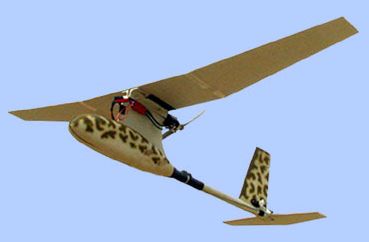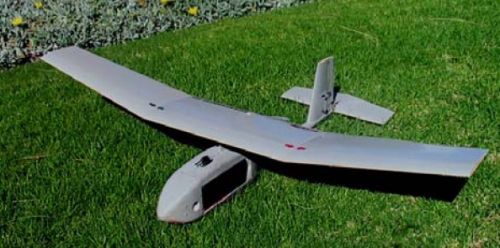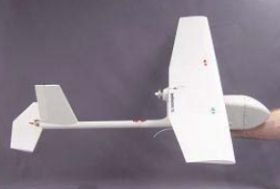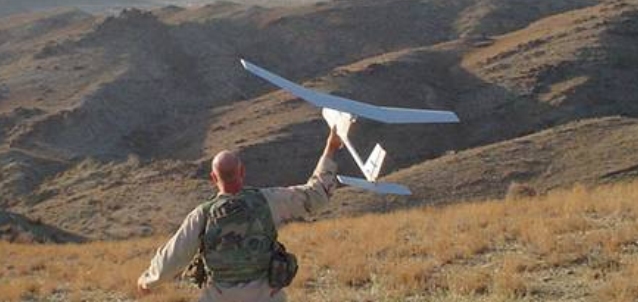AeroVironment RQ-11 Raven
In 1999, the U.S. Army bought four AeroVironment FQM-151 Pointer UAVs for the Military Operations in Urban Terrain (MOUT) ACTD (Advanced Concept Technology Demonstration) program. The Pointer system was found to be useful, but the ground control station was too large to be really man-portable. AeroVironment was therefore asked to develop a smaller station, and in turn the company also developed a smaller air vehicle, called Raven. It is about half the size of Pointer and a proof-of-concept vehicle, named the "Flashlight" SUAV (Small UAV), first flew in October 2001.
 |
| Photo: UAV Forum |
| "Flashlight" (Raven proof-of-concept vehicle) |
The "Flashlight" SUAV was further developed into the Raven in 2002 under the Army's "Pathfinder" ACTD program. The Raven prototype was hand-built and not suitable for mass production, and so the first LRIP (Low-Rate Initial Production) version was the modified Block I Raven, first delivered in May 2003. It had a new fuselage section with an easily interchangeable payload nose. Testing of the Block I UAVs revealed some drawbacks, including a difficult launch procedure and insufficient flight stability.
 |
| Photo: AeroVironment/U.S. Army |
| Block I Raven |
The Block I's shortcomings were corrected in the Block II version, which was first delivered to the Army in September 2003. The Block II was evaluated in Afghanistan, and the U.S. Special Operations Command eventually ordered a batch of 179 Raven systems with three UAVs each. The Raven has since been successfully used during Operation Iraqi Freedom, too. In late 2004, the official designation RQ-11A was allocated to the Raven air vehicle.
 |
| Photo: AeroVironment/U.S. Army |
| Block II Raven (RQ-11A) |
The RQ-11A is essentially a down-sized FQM-151 Pointer, but thanks to improved technology can carry the same navigation system, control equipment, and payload. The operation of a Raven system is effectively identical to Pointer, making transition to the new smaller system particularly easy. The Raven UAV weighs about 1.9 kg (4.2 lb), has a flight endurance of 80 minutes and an effective operational radius of about 10 km (6.2 miles). Flying speed is 45-95 km/h (28-60 mph) at typical operating altitude between 30 m and 300 m (100-1000 ft). The RQ-11A can be either remotely controlled from the ground station or fly completely autonomous missions using GPS waypoint navigation. The UAV can be ordered to immediately return to its launch point simply by pressing a single command button. Standard mission payloads include CCD color video and an infrared camera.
 |
| Photo: U.S. Army |
| RQ-11A |
As of early 2005, a total of more than 1300 Raven vehicles have been built, with about 2000 more on contract. The Army plans to decide later in the decade, if they will use the Raven as a long-term asset or if it will be replaced by so-called Micro Air Vehicles (MAVs). The Air Force's Special Operations Command also purchased some Raven systems.
In 2005, the Army decided to extend their SUAV (Small UAV) program, and started a new competition for a state-of-the-art backpackable SUAV. After a fly-off of the two finalists, the BAI Evolution XTS and the AeroVironment Raven B, the latter was announced as the winner of the competition. The Army has a requirement of more than 1000 new SUAV systems with three vehicles each, and in October, AeroVironment received a contract to start LRIP (Low Rate Initial Production) of the Raven B. The Raven B, designated as RQ-11B in 2006, is an upgraded version of the RQ-11A. Changes include a much lighter next-generation Ground Control System plus the addition of an onboard laser illuminator, as well as improvements in day and night sensors, targeting, endurance, and interoperability with battle networks.
Specifications
Note: Data given by several sources show slight variations. Figures given below may therefore be inaccurate!
Data for RQ-11A:
| Length | 1.1 m (3 ft 7 in) |
| Wingspan | 1.3 m (4 ft 3 in) |
| Weight | 1.9 kg (4.2 lb) |
| Speed | 95 km/h (60 mph) |
| Ceiling | 4500 m (15000 ft) |
| Range | 10 km (6.2 miles) |
| Endurance | 80 min |
| Propulsion | Aveox 27/26/7-AV electric motor |
Main Sources
[1] AeroVironment SUAV Website
[2] Roxana Tiron: "Army Unmanned Air Vehicles Proliferate
in the Battlefield", National Defense Magazine, May 2004
[3] AeroVironment: Raven UAV Factsheet
[4] Andrew Mawn, Phillip Tokumaru: "The Pathfinder Raven Small Unmanned Aerial Vehicle", U.S. Army & AeroVironment
Back to Directory of U.S. Military Rockets and Missiles, Appendix 2
Last Updated: 12 September 2006